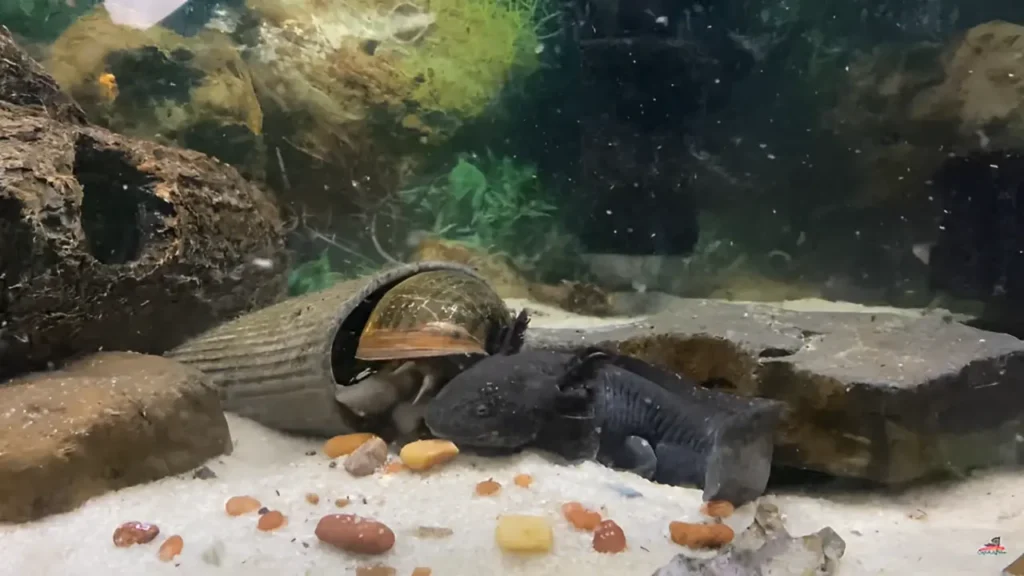Some owners of aquatic pets like axolotls—also called Mexican walking fish—often ask if it’s safe to keep snails in the same axolotl tank. While it might seem like a helpful idea to mix them together, there are serious considerations about their compatibility.
Certain types of aquarium snails are fine, especially in freshwater setups, but others might cause problems like fast reproduction or harm your axolotl’s soft skin. People usually share different opinions, and some are just myths, so learning the truth helps avoid common objections.

When I was setting up my own fish tanks, I looked at the most common combinations to find what would help my axolotls thrive with proper care and keep their house peaceful. Making an informed decision means checking all options carefully before adding anything new.
Snail and Axolotl Compatibility
From my experience, keeping certain snails with axolotls is usually not harmful, and in many cases, it can actually be beneficial. They help clean the tank by eating leftover food and algae, but there are still a few things you should consider before adding them in.
Size and Species
When choosing snails for your axolotl, it’s important they’re large enough so your pet doesn’t try to eat them. Small snails can be mistaken for food, and while that’s not necessarily harmful, it can turn into a stressful experience for both the snail and the axolotl.
Behavior
In my tank, I noticed that axolotls are generally calm and not aggressive towards snails, so they often coexist quite peacefully. Sometimes, they may gently nudge or investigate them out of curiosity, but that happens only occasionally and doesn’t cause any harm.
Tank Conditions
Since axolotls and snails have similar water requirements, they can be compatible in terms of their environmental needs. Both do well in cool, well-oxygenated water with stable parameters, which is why I’ve seen them thriving together in my setups without any trouble.
What are the Best Snails for Axolotls?
In nursery or baby tanks, Ramshorn snails are excellent tank mates because they’re bigger than a baby axolotl can eat and they help clean up uneaten food. For juvenile and adult axolotl tanks, especially ones without gastroliths, snails that are very tiny or very large are ideal.
Bladder snails, tadpole snails, and mystery snails are great choices. While bladder and tadpole snails don’t get big, apple snails can grow to golfball size or larger, making them both beautiful and interesting to watch, with the added benefits of being readily available in freshwater aquarium snails collections.
From my experience, I’ve kept many snails with axolotls for a long time without issues. But I’ve seen cases where the axolotl will catch a snail, crushes its shell, spits out the pieces, and sucks up the meat—pretty viscous behavior!.
This happens mostly with soft-shelled species like ramshorns, bladder snails, and pond snails, which don’t proliferate well in axolotl tanks. Every so often, I find remains of a mauled shell, clear proof that snail was a loser in the tank. Even thick hard shells get destroyed, though it’s rare.
One snail they mostly leave alone is the mystery snail, even the small ones. My baby, juvenile, and adult axolotls have never eaten one—just spit out after a curious bite. They may go for the tentacles thinking it resembles a worm, and nip, but they eventually lose interest.
Mystery snails are truly one of the very best tank mates, as very few species can coexist so peacefully. Even with cooler water, they do better, are less prone to disease, and their shells grow slower and harder. Plus, they feast on things your axolotl ignores, like rotten food and rotten vegetable matter.
Common Types of Freshwater Snails
Freshwater snails come in many kinds, but the most common ones are Mystery Snails, Ramshorn Snails, Malaysian Trumpet Snails, Bladder Snails, Pond snails and Nerite Snails. They are small, peaceful, and help keep the tank clean by eating leftover food and algae.
Pond Snails
I’ve seen small pond snails living peacefully with axolotls, but you have to be careful. These brown snails may seem harmless at first, but they can reproduce rapidly. Because of their fast breeding rate, they might quickly overrun your axolotl tank if not managed well. Some keepers even call them pests, though they can help with cleanup in small numbers.
Bladder Snails
Bladder snails are quite small and often get introduced into tanks accidentally—that’s how I first got them in mine. They’re similar to pond snails but have a more distinctive spiral shell. These snails can reproduce very quickly, so even a few can turn into many before you know it.
Ramshorn Snails
Ramshorn snails have a unique look with their spiral-shaped shell and come in various colors, which makes them stand out in a tank. They reproduce quite quickly, but many aquarists intentionally keep them because of their helpful tank-cleaning abilities. I’ve personally kept these snails and found them useful, especially in axolotl tanks.
Malaysian Trumpet Snails
Malaysian Trumpet Snails are known for their elongated, conical shells and how they burrow into the substrate, helping to aerate the tank bottom. While they’re useful, they can reproduce very rapidly and turn into pests if not controlled properly. I’ve used these snails before, and they do great in axolotl tanks when managed well.
Mystery Snails
Mystery snails are larger than many other species and don’t reproduce as quickly, which makes them a good choice for axolotl tanks. They come in various colors and are often kept as pets because of their calm nature and manageable population growth. I’ve had these snails before, and they were easy to care for alongside my axolotls.
Will Aquarium Snails Injure an Axolotl?
In my aquarium, I’ve never seen an axolotl get harmed by a snail. Most herbivorous species only eat DEAD plant or animal matter, not live tissue, so they aren’t attracted to the living tissues of axolotls or try to chew on them.
Snails may crawl over them if the axolotl spends time at the bottom, but that’s just to cover distance between points—they usually give a little bump, and the axie will sense it and hop immediately.
The real threat comes from carnivorous creatures like assassin snails or suckerfish, especially catfish and plecos, which may affix to the slime coat, hurt the axolotl, and even eat into its muscle for food. I’ve seen scary photos of the damage they’ve done to tiny babies.
Can Snails Give Axolotls Disease?
Some people raise the objection that snails might transmit dangerous parasites or bacteria into the tank, acting as a vector for illness or disease in axolotls. But in truth, there’s no known parasite that uses snails this way, so it’s generally safe to add them. There’s no more risk than adding a new plant. Still, I always quarantine both plants and snails before adding them, just to be cautious.

